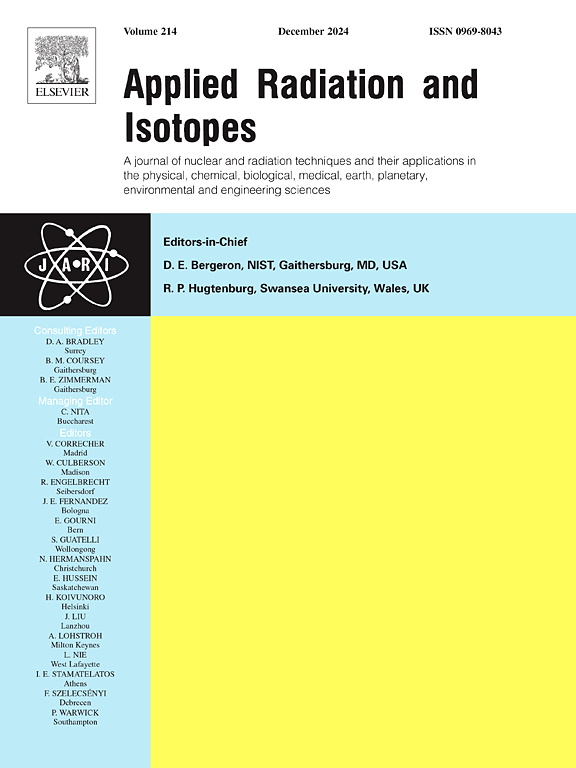Effect of Ce3+ doping on the structural, optical, and dosimetric properties of magnesium-borate glasses
IF 1.8
3区 工程技术
Q3 CHEMISTRY, INORGANIC & NUCLEAR
引用次数: 0
Abstract
Ce3+ doped magnesium-borate glasses with compositions 80MgB2O4-20MgB4O7:xCe and 60MgB2O4-40MgB4O7:xCe (where x = 0.10, 0.30, 0.50, 0.70, and 0.90 wt%), were successfully synthesized using the melt quenching method. The physical, structural, and luminescent properties of the glasses were systematically investigated through density measurements, X-ray diffraction (XRD), differential scanning calorimetry (DSC), optical absorption, spectrofluorometry, and optically stimulated luminescence (OSL). XRD patterns confirmed the amorphous nature of the glasses, while DSC provided insights into their thermal stability and phase transition behavior. The thermal stability of the 60 MBO matrix was found to be higher than that of the 80 MBO glass. An increase in glass density with higher Ce3+ concentrations was observed, accompanied by a reduction in molar volume. The indirect and direct optical band gap decreased with increasing Ce3+ content, correlating with the observed decrease in molar volume. Photoluminescence studies revealed emissions associated with Ce3+ ions incorporated into the glass matrix. Additionally, OSL measurements demonstrated the dose-response behavior of the glasses over the range of 0.02–5 Gy. Particularly, the 60MBO glass composition exhibited superior sensitivity to ionizing radiation compared to the 80MBO composition. The OSL signal of the 60MGO glass fades significantly within a few days. Long-term stability of the OSL signal should be a goal for new studies on these glasses.
Ce3+掺杂对镁硼酸玻璃结构、光学和剂量学性能的影响
采用熔体淬火法成功合成了80MgB2O4-20MgB4O7:xCe和60MgB2O4-40MgB4O7:xCe(其中x = 0.10, 0.30, 0.50, 0.70和0.90 wt%)的Ce3+掺杂硼酸镁玻璃。通过密度测量、x射线衍射(XRD)、差示扫描量热法(DSC)、光吸收法、荧光光谱法和光激发发光(OSL)等方法系统地研究了玻璃的物理、结构和发光性能。XRD图证实了玻璃的非晶态性质,DSC图则揭示了玻璃的热稳定性和相变行为。发现60 MBO基体的热稳定性高于80 MBO玻璃。观察到随着Ce3+浓度的增加,玻璃密度增加,同时摩尔体积减小。间接光学带隙和直接光学带隙随Ce3+含量的增加而减小,这与所观察到的摩尔体积的减小有关。光致发光研究揭示了与Ce3+离子结合到玻璃基体中的相关发射。此外,OSL测量显示了玻璃在0.02-5 Gy范围内的剂量响应行为。特别是,与80MBO组合物相比,60MBO玻璃组合物对电离辐射表现出优越的敏感性。60MGO玻璃的OSL信号在几天内明显褪色。OSL信号的长期稳定性应该是这些眼镜新研究的目标。
本文章由计算机程序翻译,如有差异,请以英文原文为准。
求助全文
约1分钟内获得全文
求助全文
来源期刊

Applied Radiation and Isotopes
工程技术-核科学技术
CiteScore
3.00
自引率
12.50%
发文量
406
审稿时长
13.5 months
期刊介绍:
Applied Radiation and Isotopes provides a high quality medium for the publication of substantial, original and scientific and technological papers on the development and peaceful application of nuclear, radiation and radionuclide techniques in chemistry, physics, biochemistry, biology, medicine, security, engineering and in the earth, planetary and environmental sciences, all including dosimetry. Nuclear techniques are defined in the broadest sense and both experimental and theoretical papers are welcome. They include the development and use of α- and β-particles, X-rays and γ-rays, neutrons and other nuclear particles and radiations from all sources, including radionuclides, synchrotron sources, cyclotrons and reactors and from the natural environment.
The journal aims to publish papers with significance to an international audience, containing substantial novelty and scientific impact. The Editors reserve the rights to reject, with or without external review, papers that do not meet these criteria.
Papers dealing with radiation processing, i.e., where radiation is used to bring about a biological, chemical or physical change in a material, should be directed to our sister journal Radiation Physics and Chemistry.
 求助内容:
求助内容: 应助结果提醒方式:
应助结果提醒方式:


